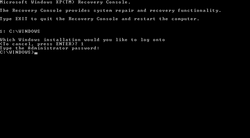Recovery Console
| Component of Microsoft Windows | |
 Recovery Console in Windows XP | |
| Type | Recovery tool |
|---|---|
| Introduced in | Windows 2000 |
| Last included in | Windows Server 2003 |
| Replaced by | |
| Windows Recovery Environment | |
Recovery Console is a diagnostic tool included on the Windows 2000, Windows XP, and Windows Server 2003 installation media, which can be used to repair system errors that prevent booting into the full Windows environment. It is a command line interface designed to resemble the Command Prompt and other console Windows utilities, however, they don't share any code and there are many differences between the Windows and Recovery Console versions of the same utilities, one of them most notably being DISKPART. The tool is implemented by the SPCMDCON.SYS driver loaded by the Windows Setup.
The Recovery Console is primarily used from the setup disc. However, it can also be installed to the hard disk by using the winnt32.exe /cmdcons command.[a] Upon a confirmation, the setup installs the Recovery Console to C:\CMDCONS and adds appropriate entries to boot.ini.
Windows Vista replaced the Recovery Console with the WinPE-based Windows Recovery Environment, which features a full graphical interface and implements most of the same functionality in wizards.
Commands[edit | edit source]
The Recovery Console supports many Command Prompt commands as well as includes some custom ones, which can be broken down into several categories.
Command Prompt counterparts[edit | edit source]
The following commands share largely the same behavior with Command Prompt built-in commands, mostly dealing with file management:
ATTRIB– manipulates file attributesCD/CHDIR– changes or prints the current working directoryCLS– clears the screenCOPY– copies filesDEL/DELETE– deletes filesDIR– prints the contents of a directoryEXIT– exits the Recovery Console and reboots the computerHELP– prints a list of supported commands or details about their usageMD/MKDIR– creates a directoryRD/RMDIR– removes a directoryREN/RENAME– renames a file or directorySET– sets or prints environment variablesTYPE/MORE[b] – prints the contents of a file
External command counterparts[edit | edit source]
The following commands are similar to certain external commands included with Windows; however, they are not completely compatible with their regular counterparts' behavior (if at all):
BOOTCFG– manipulates theboot.inifile[c]CHKDSK– checks a file system for errorsDISKPART– disk partition editor; unrelated to the regular DiskPartEXPAND– expands compressed files from the installation mediaFORMAT– formats a volumeNET– connects to a network share[d]
Exclusive to the Recovery Console[edit | edit source]
The following commands are exclusive to the Recovery Console:
BATCH– executes commands in a text file, similarly to a batch fileDISABLE– disables a serviceENABLE– enables a serviceFIXBOOT– writes the Windows volume boot record to specified volumeFIXMBR– writes the Windows master boot record to specified diskLISTSVC– lists all registered servicesLOGON– logs the user onto a Windows installation; runs at startMAP– displays drive letter mappingsSYSTEMROOT– changes to the system directory
Notes[edit | edit source]
- ↑
winnt32.exeis located on the Windows setup disc, in a subdirectory depending on the target architecture (i386for IA-32,amd64for AMD64, oria64for IA-64). - ↑ The
MOREcommand is recognized only as an alias for theTYPEcommand, which does not entirely match its usual syntax. Notably, it cannot be used to optionally paginate the output of a command; however, the output of all commands is already paginated automatically, removing the need for the command. - ↑ Introduced in Windows XP.
- ↑ The usability of the command is disputed, as there are no network stacks loaded in the Recovery Console.